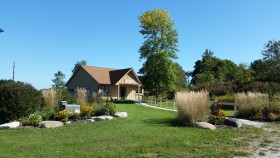October is the most colorful month at Crossroads, and October 1st may well be the most colorful day. We will see the reds of Sturgeon Bay and Sevastopol, the yellows of Algoma, and the purples of the Providence Academy as the cross-country teams of these schools run through the fields and forests of the Crossroads preserve.
Participants and spectators are encouraged to use the Astronomy Campus Entrance at 2200 Utah Street, so the first color they see will be the new landscaping at the Stonecipher Astronomy Center. Members of Master Gardeners of Door County and the Door Peninsula Astronomical Society, under the direction of Barb Henkelmann (who is a member of both groups) planted and have cared for the flowers and shrubs. And for the first year, the plants are stunning.
But the plants along the trails are perhaps even more spectacular—–riots of showy purple, yellow and white blossoms. Colorful flowers have a function. The vivid petals attract insect pollinators—bees, butterflies, flies, mosquitoes [yes, mosquitoes are pollinators] which visit the blossoms to collect nectar and pollen. Understand that to insects, not all colors are equally attractive. It really helps if a flower is a color that bees can actually see.
And honeybees don’t see the same colors we do. Researchers tell us that apparently, bees, domestic and wild, do not see red, but they can see ultraviolet, a color not visible to humans. (We perceive ultra-violet as white.) It is no coincidence that wildflowers in both spring and fall are purple, yellow, and white. In contrast, wind-pollinated flowers are usually inconspicuous, small, and green or brown.
Gardeners and orchard growers think a lot about pollinating insects when vegetables need pollination and orchards are in bloom. So important are the pollinating services of bees, that some area orchardists rent hives of honeybees which are trucked in to help with the pollinating.
But much of the actual pollination is done by local bees which brings up an important issue: Bees need nectar and pollen throughout the growing season, not just during “blossom time” in the orchards. Pollinators find food at Crossroads and other natural areas, but in places that are regularly mowed……mowed before flowers bloom or set seed….. the health of the bees is jeopardized. In places where hay is harvested, mowing does have a place, but I simply don’t understand why anyone would want to mow fall flowers which are both beautiful and food sources for insects, birds, and small mammals.
The cross-country meet will be held the first of the month, but throughout October, hikers, runners, dog walkers, and school groups can enjoy the fall flowers and colorful deciduous trees. Celebrate the season by getting out on the trails at Crossroads, the Big Creek Cove and the Ida Bay Preserve.
Curiously, at the monthly meeting of the Door Peninsula Astronomical Society at 7:00 on Tuesday, October 5, the feature program, “NASA SOFIA Mission” will also relate to colors…. in a way. Speaker Gary Henkelmann will explain that until very recently, telescopes could only detect visible light—the light we see as colors. That limited the information scientists could collect to learn about other planets in our solar systems, other solar systems, stars and nebulae.
SOFIA is not just a pretty name. It stands for Stratospheric Observatory For Infrared Astronomy. It is, according the NASA website,”the largest airborne observatory in the world, capable of making observations that are impossible for even the largest and highest ground-based telescopes. During its planned 20-year lifetime, SOFIA also will inspire the development of new scientific instrumentation and foster the education of young scientists and engineers. SOFIA is an extensively modified Boeing 747SP aircraft carrying a reflecting telescope which can detect the infrared energy emitted by objects in space.”
The program will feature some of the images and information that have been collected during the SOFIA Mission. Also during the meeting, Tom Minahan will share the “Latest News in Astronomy” and refreshments will be served. Visitors always are welcome at DPAS meetings.
Crossroads is a preserve welcoming learners of all ages focused on science, history and the environment. The Collins Learning Center, located at 2041 Michigan in Sturgeon Bay, is open 2:00-4:30 daily and during scheduled events.
Thursday, October 1
4:00-6:00 Cross-County Meet
Teams participating include Algoma, Sturgeon Bay, Sevastopol, NEWCHAA and the Providence Academy. Spectators should park at the Astronomy Campus, 2200 Utah Street.The middle school race is approximately 1.5 miles. Both high school races will be a 5K course
Porta-potties will be available, but Concessions will not.
4:00 Middle School Race (boys and girls will run together)
4:30 Girls race
5:10 Boys race
Saturday, October 3
10:00 Hike at Ida Bay
Now that new trails are cut, hikers can visit the mixed hardwood forest at the northeast corner of the Ida Bay property. Meet at the parking lot on Canal Road at the Buffalo Ridge Trail intersection.
Free and open to the public.
Tuesday, October 6
7:00 October Meeting of the Door Peninsula Astronomical Society
Visitors are welcome at the monthly meetings of DPAS. Tom Minahan share the “Latest News in Astronomy” and Gary Henkelmann will present the lecture on the NASA SOFIA Mission. Refreshments are serve. Free and open to the public. Meet at the Stonecipher Astronmy Center, 2200 Utah Street in Sturgeon Bay.


